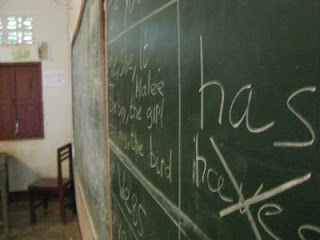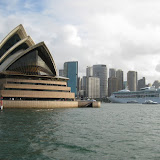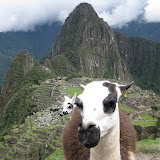
It's 4:30 am. Shut that alarm off before you wake up half the dorm. Now be quiet and come on, I've got something cool to show you..
Careful, you'll wake the staff sleeping on the floor... why did they tie their mosquito nets to the doorjamb? It's as if they don't want us to get out. Actually, now that I see the enormous padlock on the front gate... yeah we'll have to wake one up. Sorry, dude.
Cool, tuk-tuk driver is here, we're on the road. It's really peaceful out in town just a few people out for a run, a couple motorcycles on the road, a gigantic Duracell battery statue on the curb... seriously, why is that there? It's five feet tall. Who in Siam Reap's municipal government thought “Hmm, now what does our town really need? Garbage collection? Some public education funding... ooh! How about a big fake battery standing on the side of the street!”
Right, almost to Angkor Wat, the ticket booth is here... three-day pass, one-week pass... where's the one-day pass? We're paying a one day fee to the three day people? Okay, right, that works. My picture? Why do you want to take my-- okay. Right. Sure, I'll wait for it to print. Thank you! Boy my headshot looks fantastic on this ticket, especially taken at 4:45am in the dark without a flash. Onwards!
We're here. The biggest religious building in the world. If someone told me this was the biggest man-made moat too, I'd believe them. I've been crossing the stone walkway for at least five minutes... I'm through the front door and... more open air grounds. Are these counted as part of the building? Because if they are, that's cheating.
Check out those clouds. This is going to be a good sunrise. Everybody seems to be camped out inside the western entrance. Do they know something I don't? Well, considering half of them are trying to take photos of a main building several football fields away using camera flashes designed for fifteen feet, I'm guessing no. Onwards!
We're passing seven headed naga statues and pools on either side on a long stone walkway to the iconic three-domed Wat (temple). I think I was wrong, they're not counting the grounds. This thing is still big enough to be the biggest in the world. The colors are just coming out in the-- What? I'm sorry, what did you say? Corry? Coffee! Ah! No, thank you, no I don't need coffee or tea, thank you.
Almost to the entrance. I can hear bats. Smell em too. Whew, they stink. It may be dark, but I bet if I just keep going East.. as in inside... doesn't going indoors kind of defeat the purpose of getting up for a sunrise? Bah, who cares. Onwards!
Wow. It opens up into stone courtyards and stairways. Nobody else is here yet. Wow that light is amazing. Wow those stone carvings are good, I haven't seen them like that since India. Wow. Yeah, I'll be thinking that word a lot today. Wow. Now if I could just... nah, 'No entry' sign-- Hello. Fine, thanks. You? Are you sure? But it says 'no entry.' They take it away soon? Well if you're sure.
Oh man these upstairs stone carvings are amazing. Climb to the top? Eh... I don't think... pay? No. Already paid ticket. Nope. No, I'm not going past that sign, that one is permanently embedded with wood. No I'm not paying you ten dollars. Goodbye. I said no. Bye.
Out the east door. And that guy was wearing a uniform too. Or at least part of one. Hmph. But wow, is this the perfect spot to watch the sunrise or what? Second floor platform, facing east, sun rising over the jungle, reflecting all kinds of colors onto a scattered cloud cover and onto the ruins. And I'm going to run out of memory on my camera if I don't stop right now.
I don't usually like standing in one spot waiting, but it's good just taking this in. Just imagine standing on this platform, looking below onto crowds of hundreds in this courtyard. Addressing the public, 9th Century AD, Khmer Empire.
Later
Here's the main entrance again and oh my lord look at that horde of people coming at us right now. Cripes. Hey, somebody graffitied “thief” on the back of this pillar Not cool. Except, if I juxtapose it with a confused looking tourist on the other side of the shot... bingo. Heh. Now I'll just have to think of a good caption. Actually that's kinda mean. I'd hate to find that picture online of myself someday. Erase.
Mmm, just look at the lion and naga statues. One behind the other. If I set up the shot and just wait for this guy to move... and then the next guy to move. Why has he stopped? No, first guy, don't go back. Okay, sweet, now.... that was exactly the wrong time to stick your leg out. Trying again... waiting for third guy to move... bingo. Awesome-- What? No, I still don't need tea or coffee, thank you. No, I just told her I don't need tea or coffee, you haven't changed my mind. Neither have you. No, thank you, I just told them that. I'm outta here. That small temple in the grounds looks safe. I hope.
Mmm, these inner temples are peaceful. Not many images. Living chambers, possibly? Oh and that's an amazing shot with the light coming through the doorway, if I just wait for that couple in the distance. And that other couple. And this other dude. And there's another one coming. Come on dude, speedwalk! You can make it before they get here! Ten steps. Five Steps. Four. Three. Two-- no! No, don't stop for a picture! Argh, now the couple's in the shot too. And another. Come on... look cool, lower the camera, smile. You don't need to make people uncomfortable, especially at this time in the morning. Wait. A bit more. Just a bit more. And they're gone. Just in time for two more people to arrive. Screw it, there are people in Angkor Wat, there will be people in the pictures.
Can't be here forever. Le's go meet the tuk-tuk. Hello. No, thanks I don't need a book. No, I don't need a tuk-tuk, I've got a-- yes, I'm sure they're great guidebooks but I'm not- no thank you, I don't need a drink. Yes, I'm sure. I don't want a special price. No I don't need a discount. No, I'm not interested in bracelets, how about you trade with this dude selling books? Or that one on the tuk tuk? I'm guessing the twelve other kids here selling bracelets don't want yours. No. No. Really, thanks, but no.
Outta there! Driving on with the tuk tuk to the the next complex. This moat is just as big on the sides. Wow. And are those...? They are! Hello, monkeys! Man, haven't seen any in the wild since Thailand! I'd better watch my pockets, I still remember stories about the camera snatching monkeys in India and Bolivia.
And we're here, I'm stepping out of the-- no, thanks I don't need breakfast right now, you can hold onto your menu, thanks-- stepping out of the tuk-tuk. This part is pretty much empty. Sweet! Looks like someone has taken this place apart in chunks and put half of it back together. Looks like the “someone” is “JASA”? Japanese restoration group. Hunh. Very cool looking. No climbing of course.
Hang on, that's definitely a Shiva linga. I thought these guys were Vaisnavite. Huh. I guess crossover makes sense. Anyway the four-faced pillars could easily stand for Bhrama and hardly anyone cared much about him, why not a random linga for Shiva. It's not very big... why am I making observations about the size of intentionally phallic religious monuments again?
I wonder how they knew this was a library. Or if it really was one, they might just be calling it that in these signs. Amazing stuff though. I bet I could take a picture in any direction without looking and have it come out great. One, two, aaaand, bam! ...hey, not bad! I'm keeping that one. And this is just the beginning! Time to explore!
Later
Awesome stuff. Good restoration work, even if chunks are still piled everywhere. Maybe those were the ceiling once upon a time. Heading out now... maybe I will grab breakfast.
Thank you. Curry? Two dollars? Rice included? Fantastic. Thank you! Oh boy, and here come the little kids. Hi. No, I don't need a bracelet. Or a statue. What? It's Joel. What's yours? What country am I from? The United States. No, it's impressive if you know the capital but it won't make me buy. No, thank you. No ,thank you. No thank you. Nothankyou. No. No, thank you very much, but no. Yes, very pretty. I don't need a good price, I said no. Bye. Oh boy, here's number two. No thank you. The United States. Washington State. Very impressive, but no, I'm not going to buy if you name the capitals. No thank you. Bye. Hi. Yes they're very small. Yes it's an elephant. Yes, that's Ganesh. No, thank you. The United States. Washington state. No, I already know my country's capital, my state capital, who my president is and roughly what the population is. Thank you, no. That's very good. No. No, thank you. I see that. No, thank you. Actually it's pronounced Olympia, but that's still very good. No, thank you. Yes, I see they're very nice, I still don't want to buy. No, thank you. No, I don't know the capital of Madagascar. No, I will not buy one if you tell me what the capital is. Bye.
Mm! Food! Thank you! Mm. Good stuff. Two free bananas? Seriously? I mean, thanks, but...
Hey, you! No, I still don't want a bracelet. No. But are you hungry? You like bananas? Yeah, seriously. Here. You're welcome. Hi there! No, thank you, I don't want pineapple, I just ate. Are you allowed to eat those bananas? I said are you-- oh forget it. Do you want this one? Go for it! You're welcome.
Okay, next temple. I think this is the one my guidebook said actually was a jigsaw puzzle-- archaeologists dismantled it keeping careful records that the Khmer rouge then destroyed in the civil war. No I don't need a drink. No I don't need a coconut. I don't care if it's a good price. No. Anyway, the entrance opens to an elevated walkway sitting on top of pillars. Looks like the French helped with this-- yes, the reclining buddha is that way, I know, thank you. What country am I from? Nicaragua. Ni-car-ag-ua. Bye.
Are those funnel web spiders? I mean, they're spiders, those are webs, and they're awfully funnel-shaped. They're all over the place, now that I look. How did I not notice those before? Are they venomous? Not that I was planning on picking one up.
Thinking of dangers, I know Cambodia is full of land mines, almost as bad as Laos is with cluster bombs. I've been warned to stay on the beaten path at all times in general. I wonder if anyone has ever gotten hurt from a mine here since the war ended. This must have been a huge battleground, there must have been some weapons here somewhere, or did respect keep them out? This place is a national symbol after all. Just look at the flag-- blue and red with a white Angkor Wat in the middle.
Still, I'm exploring the forest where the royal palace once stood, and I think I'll stick to the beaten pathways. Very peaceful. Yes, very nice paintings. No thank you. Mmm. Hey, look some kids are bathing in the middle of a pool. I've seen more naked kids running around Southeast Asia than just about anywhere in the-- are they waving at me? They're making a sign. A sign of taking a picture. They're asking me if I want to take their picture. You're telling me a group of kids has set up shop, bathing naked and getting people to give them money for taking their picture? I'm pretty sure there are extradition treaties with that kind of business deal in mind. No, thanks, enjoy the bath!
Later
I can't believe just how extensive these temples are-- I'm covering a tiny fraction and I've already seen so many! This one though... they picked this one to film Tomb Raider on for a reason. This really feels like how you expect a ruin to feel. Surprisingly few ruins do. Trees growing out and on top of a crumbling maze of religious carvings and hallways, monkeys and geckos sounding off in the background. India was the partner to help restore this one. Maybe not the best job technically, but probably the best work I've seen to preserve the feeling of the place. Makes sense, if you want to preserve Hindu temples, call in the country that, its own language, calls itself Hindustan. Now I just have to find the exit. Where's that music coming from?
Mine victims. “We wish to live with dignity. We do not beg. We make music...” Good cause. Wish I had something smaller than a twenty. I think I heard these guys in town last night, maybe I'll drop them something later. We're almost to the exit, just around this line of trees.
Oh dear lord it's an army. No. No. No I don't. Nope, sorry. Already have one. No, don't need one. No, not thirsty. Can't carry more books. No. No. No no no. Where's my camera? This is going on video. No. Thank you, but no. No thank you. No. Please let go of the tuk-tuk. No. Now the driver's getting annoyed. Please don't get hurt. Thank you. Bye!
Later still
And back at my guest house! I don't want to know what time it is. I just need to get change. Driver doesn't have any. I'll ask at the guesthouse. I'll just hand over the twenty... it getting handed over to a little shirtless kid who's taken off running. Uhh-- yes, I can wait.
You know, this driver has been very good. I haggled the price down a bit much. I realize seven dollars is a lot more here than it is back home but still, it's not much. I know it's not customary around here, but he deserves a tip. He's been efficient, friendly, and above all he hasn't tried to sell me anything. I'll go see him for second.
Hey there! We're just waiting for my change. Yes. What? Do I want what? Boom boom? No, I do not want boom boom. No, I'm not married. Why not? Because it's illegal, and I don't like paying for that kind of thing. Yes. Okay. Here's comes my change. Thanks, kid. Here's your seven dollars. Thank you very much! Bye!
---
Check out this entry's
Photos.
 On a bus from Cambodia to Vietnam, I was reading Dispatches by Michael Herr. It's the story of a reporter in Vietnam during the war. I ended up bouncing back and forth between the Vietnam countryside around me and the same place forty years ago, ripped apart by a war between the people here and the people from my home. I was headed to Ho Chi Minh City, which people there still call by it's old name: Saigon. I looked up from the tanks officers and soldiers picking up body parts of 1968 to the swarm of motorcycle drivers filling every street in 2009.
On a bus from Cambodia to Vietnam, I was reading Dispatches by Michael Herr. It's the story of a reporter in Vietnam during the war. I ended up bouncing back and forth between the Vietnam countryside around me and the same place forty years ago, ripped apart by a war between the people here and the people from my home. I was headed to Ho Chi Minh City, which people there still call by it's old name: Saigon. I looked up from the tanks officers and soldiers picking up body parts of 1968 to the swarm of motorcycle drivers filling every street in 2009.













 Questions? Comments?
Questions? Comments?